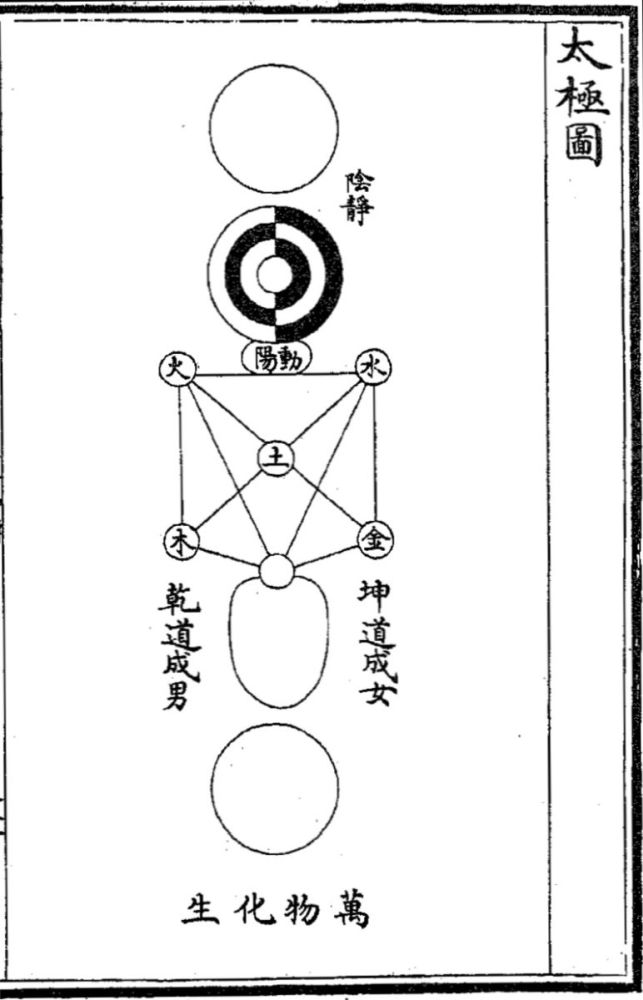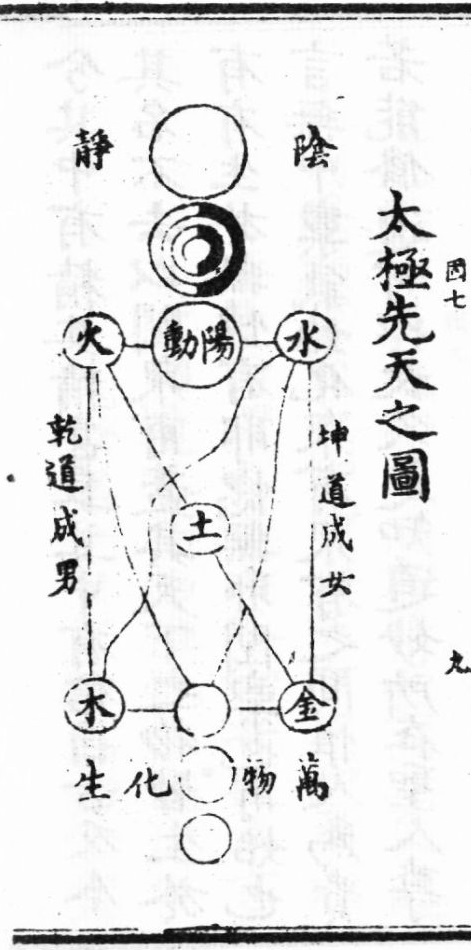May 6, 2021 © Ulrich Theobald
Taiji tushuo 太極圖說 "Explanation of the diagram of the Utmost Extreme" is a brief text on Neo-Confucian cosmology written by Zhou Dunyi 周敦頤 (1017-1073). The idea is derived from an image of the "non-dimension" (wujitu 無極圖) or the "anterior Heaven" (xiantiantu 先天圖) created by the Daoist master Chen Tuan 陳摶 which came upon Zhou Dunyi via the teachings of Zhong Fang 種放 (955-1015) and Mu Xiu 穆修 (979-1032). Huang Zongyan 黃宗炎 (1616-1686) was of the opinion that the Taijitu had been invented by Master Heshang 河上公 (1st cent. CE), who is famous for his commentary on the Daodejing 道德經. From that source, the image was transmitted by Chen Tunan 陳圖南 (i.e, Chen Tuan 陳摶, 871-989), who used it to describe skills of inner alchemy (xiulian 修煉). Zhu Xi 朱熹 (1130-1200) held that the text was often appended to Zhou's book Tongshu 通書, with the result that many readers believed the Taiji tushuo was the last chapter of this book.
The text of the Taiji tushuo explains that the non-dimension and the Utmost Extreme were the two original conditions of the cosmos in which movement (dong 動) and standstill (jing 靜) of matter were effected according to the influence of the two "energies" or potentials (liang yi 兩儀) Yin and Yang 陰陽. With the change from Yin to Yang, shapeless substance came under the control of the Five Agents (wuxing 五行): water, fire, wood, metal, and earth. Thereafter, the ten thousand objects and beings (wanwu 萬物) found their shape. Those in which Yang or the force of the hexagram (see Yijing 易經) Qian 乾 prevailed were males, while dominance of the Yin hexagram Kun 坤 produced females. These shapes were subject to constant movement and transformation. "Non-dimension" means that all matter existed as an idea, but without a shape. The shape was only created by transformation from the status of non-dimension to "extreme dimension" (taiji).
The most intelligent and flexible (zui ling 最靈) beings were humans. For humans, an archetypical "human extreme" (renji 人極) existed in the origins of the cosmos in which the Confucian virtues of keeping to the golden mean (zhong 中), uprightness (zheng 正), kindness (ren 仁) and righteousness (yi 義) were endowed, as well as the potential to return to primordial quiescence (jing), which meant in practice abstention from improper desires (wuyu 無欲).
The text combines the Daoist belief in the Taiji with Confucian concepts of change as seen in the Classic Yijing "Book of Changes". The original title of the text was, therefore, Taijitu yishuo 太極圖易說 "An explanation of the image of the Utmost Extreme by use of the Changes". It was one of the first Neo-Confucian texts of the Northern Song period 北宋 (960-1126) and had a great influence on the cosmology of this philosophical trend.
Fig 1ab. Reconstructions of the Diagram of the Utmost Extreme
 |
 |
The blank circle at the top symbolizes Yin and quiescence ( yin jing 陰靜), and the mixed black-white circle set in the second position Yang and movement ( yang dong 陽動). The crossed lines represent the interaction of the Five Agents water, fire, wood, metal, and earth. Influence of the Hexagram Qian produced male things ( qian dao cheng nan 乾道成男), and that of the hexagram Kun female ones ( kun dao cheng nü 坤道成女). The lowest circle(s) stand for the ten thousand beings that have come into existence ( wanwu hua sheng 萬物化生). Left: According to Zhu Zhen 朱震, Hanshang Yizhuan 漢上易傳, appendix Guatu 卦圖 ( Chizaotang Siku quanshu huiyao 摛藻堂四庫全書薈要 edition). Right: According to Shangfang dadong zhenyuan miaojing tu 上方大洞真元妙經圖 in Zhengtong daozang 正統道藏 ( Dongxuan bu 洞玄部, Lingtu lei 靈圖類). |
The text is preserved in three versions, namely Zhu Xi's paragraph-and-sentence commentary Taiji tushuo zhangju 太極圖說章句 (also called Taiji tushuo jie 太極圖說解), the biographical collection Song-Yuan xue'an 宋元學案, and a (lost) original chart mentioned by Zhu Zhen 朱震 (d. 1138). Zhu Xi even changed the original, for instance, the first sentence, from the wording "out of the non-dimension, the Utmost Extreme emerges" (zi zuji er wei taiji 自無極而為太極), to the phrase "the non-dimension is also the utmost extreme" (wuji er taiji 無極而太極).
The imperial series Siku quanshu 四庫全書 includes Cao Duan's 曹端 (1376-1434) commentary Taiji tushuo shuije 太極圖說述解. Another important edition is Wang Jianchang's 王建常 (1615-1701) commentary collection Taiji tushuo jijie 太極圖說集解. Studies were written by Huang Zongyan (Taijitu bian 太極圖辨) and Mao Qiling 毛奇齡 (1623-1716, Taiji tushuo yiyi 太極圖說遺義). The text is found in Zhou Dunyi's collected writings Zhouzi quanshu 周子全書.
Sources:
Adler, Joseph A. 2015. "On Translating Taiji." In Returning to Zhu Xi: Emerging Patterns Within the Supreme Polarity, edited by David Jones, and He Jinli, 51-81. Albany, NY: State University of New York Press.
Cai Jiahe 蔡家和. 2020. "Lun Wang Chuanshan yi Zhengmeng shi Taiji tushuo 論王船山以《正蒙》釋《太極圖說》." Zhoushan xuekan 船山學刊 2020 (6): 14-22.
Cao Shuming 曹樹明, and Tian Zhizhong 田智忠. 2003. "Taiji tu yu Taiji tushuo zhi wuxing shuo bijiao yanjiu 《太極圖》與《太極圖說》之“五行說”比較研究." Zhouyi yanjiu 周易研究 2003 (4): 13-18.
Chen Guying 陳鼓應. 2012."Lun Zhou Dunyi Taiji tishuo de daojia xuepai guanxi: Jian lun Lianxi de daojia shenghuo qingqu 論周敦頤《太極圖說》的道家學脈關係——兼論濂溪的道家生活情趣." Zhexue yanjiu 哲學研究 2012 (2): 28-37+128.
Chen Keming 陳克明. 1987. "Taiji tushuo 太極圖說." In Zhongguo da baike quanshu 中國大百科全書, part Zhexue 哲學, vol. 2, 860. Beijing and Shanghai: Zhongguo da baike quanshu chubanshe.
Chen Ying 陳瑛, and Xu Qixian 許啟賢, eds. 1989. Zhongguo lunli da cidian 中國倫理大辭典, 683. Shenyang: Liaoning remin chubanshe.
Cui Xichen 崔希晨. 2022. "Taiji tushuo yinyang gainian tanxi 《太極圖說》“陰陽”概念探析." Huaxia wenhua 華夏文化 2022 (2): 14-16.
Ding Weixiang 丁為祥. 2018. "Yuzhou benti lun yu benti yuzhou lun: Jian lun Zhuzi dui Taiji tushuo de quanshi 宇宙本體論與本體宇宙論——兼論朱子對《太極圖說》的詮釋." Wen-shi-zhe 文史哲 2018 (4): 40-49+165-166.
Lang Jiachen 郎嘉晨. 2023. "Taiji tushuo shengren ding zhi yi zhongzheng renyi gou tanwei: Cong Zhuxue de shijiao kan 《太極圖說》“聖人定之以中正仁義”句探微——從朱學的視角看." Chuanshan xuekan 船山學刊 2023 (5): 120-128.
Jin Zhengen 金珍根. 2014. "Laozi de yuzhou shengcheng lun dianfan yu Zhou Dunyi de Taiji tushuo 老子的宇宙生成論典範與周敦頤的《太極圖說》." Chuanshan xuekan 船山學刊 2014 (4): 64-71.
Kui Le 蒯仂, Wu Renjie 吳人傑, and Zou Chunpu 鄒純朴. 2017. "Taiji tushuo yu mingmen xueshuo 《太極圖說》與“命門學說”." Zhongguo Zhongyi jichu yixue zazhi 中國中醫基礎醫學雜誌 23 (3): 297-298.
Li Kun 李坤. 2024. "Song-Ming lixue fenxi he xushu fangfa fanshi: Yi Jinsilu yu Taiji tushuo wei li 宋明理學分析和敘述方法範式——以《近思錄》與《太極圖說》為例." Gujin wenchuang 今古文創 2024 (30): 56-58.
Li, Lizhu. 2017. "Influence of Interaction: A Study of Zhu Xi's Reading of the Taijitu Shuo and the Tongshu." Asian Philosophy 27 (4): 369-377.
Liu Cong 劉聰. 2008. "Taiji tushuo daojiao yuanyuan tintan: Jian lun wu ji er tai ji zhi shuo de xingcheng 《太極圖說》道教淵源新探——兼論“無極而太極”之說的形成." Guanzi xuekan 管子學刊 2008 (3): 71-75+100.
M'Bondjo, Maud. 2010. "Les notions de taiji et de cheng dans la pensée de Zhou Dunyi (1017-1073): parallélisme, identification et dissymétrie." Études chinoises 29: 289-300.
NN. 1959. "Guowai dui Zhou Dunyi Taiji tushuo de yanjiu 國外對周敦頤“太極圖說”的研究." Zhexue yanjiu 哲學研究 1959 (3): 43.
van Norden, Bryan W., and Justin Tiwald. "'Explanation of the Diagram of the Great Ultimate'." In Readings in Later Chinese Philosophy: Han Dynasty to the 20th Century, edited by Justin Tiwald, and Bryan W. van Norden, 136-139. Indianapolis: Hackett.
Peng Huan 彭歡. 2024. "Taiji tushuo Deguo shouyi ji qi Zhongguo zhishi laiyuan kao 《太極圖說》德國首譯及其中國知識來源考." Xiangnan Xueyuan xuebao 湘南學院學報 45 (6): 24-27+43.
Shu, Jingnan. 1990. "A Reconsideration of Zhou Dunyi's Tai ji tu shuo; tr. by Huang Weiwei." Social Sciences in China 11 (1): 158-185.
Song Zhiming 宋志明. 1997. "Taiji tushuo 太極圖說." In Zhongguo ruxue 中國儒學, edited by Pang Pu 龐樸, vol. 3, 180. Shanghai: Dongfang chuban zhongxin.
Sun Xiaochun 孫曉春, and Zhao Ronghua 趙榮華. 2010. "Zhou Dunyi Taiji tishuo de zhengzhi zhexue jiedu 周敦頤《太極圖說》的政治哲學解讀." Shandong Daxue xuebao (Zhexue shehui kexue ban) 山東大學學報(哲學社會科學版) 2010 (5): 2-8.
Sun Yikai 孫以楷. 1992. "Zhu Xi yu Taiji tushuo 朱熹與《太極圖說》." Kongzi yanjiu孔子研究 1992 (3): 32-36+114.
Tian Zhizhong 田智忠, and Wang Honghai 王宏海. 2010. "Taiji tu yu Taiji tushuo zhi guanxi zai kaocha 《太極圖》與《太極圖說》之關係再考察." Zhouyi yanjiu 周易研究 2010 (2): 30-36.
Wang, Robin R. 2005. "Zhou Dunyi's Diagram of the Supreme Ultimate Explained (Taijitu shuo): A Construction of the Confucian Metaphysics." Journal of the History of Ideas 66 (3): 307-323.
Wang Yongyan 王永炎, and Fan Yipin 范逸品. 2024. "Du Taiji tushuo du renwen yixue de yiyi 讀《太極圖說》對人文醫學的意義." Tianjin Zhongyiyao 天津中醫藥 41 (5): 545-547.
Wei Houbin 魏後賓. 2019. "Cong taiji tu jie Taiji tushuo: Jian lun taiji tu rujiahua de zhongyao yiyi 從太極圖解《太極圖說》——兼論太極圖儒家化的重要意義." Chuanshan xuekan 船山學刊 2019 (4): 44-52.
Wyatt, Don J. 2003. "Taijitu shuo (Diagram of the Supreme Ultimate Explained)." In RoutledgeCurzon Encyclopedia of Confucianism, edited by Yao Xinzhong, 593. London and New York: RoutledgeCurzon.
Xia Zhenping 夏鎮平. 1988. "Zhou Dunyi Taiji tushuo yu Zhu Xi Taiji tushuo jie bianyi 周敦頤《太極圖說》與朱熹《太極圖說解》辨異." Kongzi yanjiu 孔子研究 1988 (2): 74-78.
Xu Hongxing 徐洪興. 2000. "Zhou Dunyi Tongshu, Taiji tushuo guanxi kao: Jian lun Zhou Dunyi de benti lun sixiang 周敦頤《通書》、《太極圖說》關係考——兼論周敦頤的本體論思想." Zhongguo zhexue shi 中國哲學史 2000 (4): 80-89.
Yang Lihua 楊立華. 2012. "Tiyong yu yinyang: Zhuzi Taiji tushuo jie de benti lun jiangou 體用與陰陽——朱子《太極圖說解》的本體論建構." Zhexue yanjiu 哲學研究 2012 (10): 65-70.
You Sen 游森. 2022. "Lun Zhang Shi de benti yu gongfu guan: Yi Taiji tushuo jieyi wei hexin 論張栻的本體與工夫觀——以《太極圖說解義》為核心." Zhouyi yanjiu 周易研究 2022 (4): 88-92.
Zhang Simin 張斯珉. 2023. "Jian zong Ru-Dao de wei ding zhi lun: Zhou Dunyi Taiji tushuo xinjie 兼宗儒道的“未定之論”——周敦頤《太極圖說》新解." Zhouyi yanjiu 周易研究 2023 (6): 79-88.
Zhang Xianglong 張祥龍. 2005. "Zhou Dunyi de Taiji tushuo, Yi xiangshu ji xifang youguan xueshuo 周敦頤的《太極圖說》、《易》象數及西方有關學說." Xiandai zhexue 現代哲學 2005 (1): 80-95.
Zhao Jihui 趙吉惠. 1988. "Taiji tushuo 太極圖說." In Zhongguo ruxue cidian 中國儒學辭典, edited by Zhao Jihui 趙吉惠, and Guo Hou'an 郭厚安, 409. Shenyang: Liaoning renmin chubanshe.
Zhou Zucheng 周祖成, and Li Sichuan 李四川. 2020. "Ziran zhixu yu tiyong: Taiji tushuo de fa zhexue sixiag 自然秩序與體用——《太極圖說》的法哲學思想." Xueshujie 學術界 2020 (3): 145-153.

